Afghan Reconstruction
The Census Process
Introduction
One of the most important duties of the rehabilitation
and reconstruction process in
Afghanistan will require for a proper and thorough census to be conducted. A
partial census was conducted by some group in the 1970's, however data for that is
not public. As to who had conducted it or as to its thoroughness, also cannot be
substantiated. So leaving the past aside, one would assume that with the advent
of the current interim government, a formation of a department for Interior or
a department for the Return of Refugees would indeed be in some way responsible
for liasing with the UN and affiliates for conducting such a
formidable task, yet it is unclear as to which of these
departments will burden the will to conduct such a dawnting task.
Afghanistan in it's past has always required
it's citizens to bear identity (Taskira) cards, required at all
times generally for identification purposes. With registration data being non
centralised and based on locality, the documentation
for the registered were kept in regional civic institutions. Not all rural citizens were registered, and
with the chaos that had gripped the country, no decent calibration
system for population had been provided for, and if it had, it would not serve sufficient use for
todays purpose as it is neither digitally nor comprehensively available. A
system therefore must be devised to accommodate for a census, that would not
only procure a population survey, but also distribute modern identity cards. The reason for
this two pronged approach is simple, it not only produces a concise populous
figure, it will also ensure that the survey had been conducted accurately. The approach
Advocates would argue that any issuance of identity cards would be over kill for the purposes of
any emergency initial task, however I would strongly disagree to any other approach other than
the issuance of a sophisticated card system. The information would hold the issuers
personal details, finger print, identity number, picture, tribe and location etc..
With this data it would be possible for all governmental bodies to conduct
and forecast their responsibilities with accuracy, and to allow the
many aid agencies to do likewise. It will also allow for future accurate
and cost effective surveys, planning, and most important of all, elections for a
democratic government. Practicality
Today there are, systems that will allow a team to conduct
practical regional surveys of demographically defined areas merely equipped
with the following exampled equipment .

|
portable system for use at frequently changing locations. Personal details (image and text data) are captured live during the application procedure. Lighting and camera technology are specially adapted for fast, high-quality capture of the image and text data. Special features of this model are rugged design, low weight, extremely short set-up times and low energy consumption.
Main components:
- Rugged laptop, operating system and IMAGO
application software
- CCD colour video camera
- Colour frame grabber card
- Barcode reader
- Backdrop, lamps, camera and lamp mount
- Padded portable case
|
The
team should be composed of 4-5 Afghans with
the following roles:
Driver - Responsible for security and transport, water, food, fuel, generator
and must be locally known.
Team Leader -
Leader and main contact with central. Resonsible, ethical person
able to conduct survey / questionaire.
Technical - Required to conduct photos and general
use of equipment including finger printing equipment.
2 x Workers - Cooking, cleaning, buying, packing , tents , seats etc.
The team is equipped with a jeep and tents as they will be in the field most
of the time, relaying back information to central approximately 150-250 personnal
infos per day. The cards will be issued centrally and be dispatched at a later
date. Central Processing
A central processing department will be available in the capital and be
responsible for datawarehousing and card issuance and dispatch. An example
of the equipment required for such high volume card issuance is shown
below.

|

|

|

|
|
| LUCHS 5000 card personalization system
The basic configuration of the LUCHS 5000 card personalization system consists of one transport, one input, one output and one console module for system control.
There are different versions available offering various personalization rates and functions (i.e. manual or magazine input).
|
Laser Engraving Module
This module is available in three variants:
- LL-1 High-volume production of ID cards (high
engraving speed, 256 grey levels, personalization on both sides)
- LL-2 Medium-volume production of ID cards
(lower engraving speed, 256 grey levels, personalization on both sides)
- LL-3 High-volume production of ec, mobile
phone, insurance and multi-function cards (high-speed engraving on one
side only, no image engraving)
|
Magnetic Stripe Encoding Module
- LM-1 LOCO/HICO magnetization with 300/2,750
oersted
- LM-2 HICO magnetization up to 4,000 oersted
|
Chip Encoding Module
8 contacting units in one chip encoding module.
Personalization rate 1,500 cards/h at a maximum personalization rate of 16 seconds per card
|
|
Requirements & Costings
The table below shows the fixed cost requirements for this task for one
year:
| Required
|
Number
|
Approx Unit Cost $
|
Cost $
|
| Vehicles
|
100
|
20,000
|
2,000,000
|
| Man Power
|
500
|
4,000
|
2,000,000
|
| Tents
|
300
|
150
|
45,000
|
| Chairs
|
800
|
8
|
6,400
|
| Tables
|
300
|
23
|
6,900
|
| Cooking Facilities
|
100
|
150
|
15,000
|
| Beds & Blankets
|
500
|
150
|
75,000
|
| Jackets
|
500
|
100
|
50,000
|
| Shower equipment
|
100
|
100
|
10,000
|
| Fuel
|
100
|
1000
|
100,000
|
| Repair equipment
|
100
|
300
|
30,000
|
| First Aid & Medicine
|
100
|
100
|
10,000
|
| Generators
|
100
|
250
|
25,000
|
| Day Cover
|
100
|
150
|
15,000
|
| GPS Satellite Phone
|
100
|
1000
|
100,000
|
| Portable ID System
|
100
|
5000
|
500,000
|
| Radio
|
100
|
30
|
3,000
|
| Sub Total
|
4,991,300
|
It would be assumed that working 6 days per week
and producing about 200 ID's per day per vehicle, a total of
approximately 6 Million ID's can be achieved during one year cycle of
surveyance activity. In the major cities however fixed units will be deployed .
These units will have similar costs attached to them excluding the costs associated with
vehicles, tents etc. Assuming 2-3 ID systems in each major city The cost per ID is estimated
at approximately $0.50 per ID, however this does not include the processing and
delivery of ID cards.
The table below shows the fixed cost requirements for card production and
delivery: Reasoning Biometrics
An electronic device verifies the identity of a person
through the use of a personal attribute, such as hand or finger shape,
fingerprint, voiceprint, signature dynamics, retinal pattern, or iris pattern .
These devices, known as biometric identifiers, can be very accurate in the
identification of persons. The chances of such devices
mistakenly identifying an unauthorized person is usually much lower than
the chances of a guard inaccurately matching faces to picture badges. Biometrics
are commonly used in high-security applications where unauthorized access into a
facility is crucial.
Basically identification is unique and cannot be lent to other people. There
is nothing for a Person to forget to bring with him or her. Hand or finger
geometry appear to be the most viable, affordable, and user friendly biometric
devices for medium- or low-security applications as is in this case.
Portable devices are subject to damage from misuse. It usually takes longer
to use a biometric device than a card reader or keypad. A stand-alone biometric
unit can run between $1,200 and $5,000.
Contributing to Lower Costs
Factors that drive up the cost of the registration include the
following:
- Use of voter identification cards, especially photo-identification cards.
Although the cost of this item tends to be high, the improvement in the
ability to positively identify each qualified voter that results may make this
cost a reasonable expenditure.
- Low population density. This factor, which obviously is beyond the control
of the election authority, requires a larger number of registration officers,
election districts, or registration centres. A key principle guiding
registration is that voters should not bear unnecessarily high costs,
including costs of transportation, or time away from work, in order to
register to vote. It is incumbent upon the election administration authority
to ease the burden of registration, even if this means setting up a relatively
large number of registration centres, or using mobile registration centres.
- The use of nonstandard materials. Whenever the materials used in the
registration drive are not consistent with the industry standard, where
applicable, the costs of production will increase. For example, when producing
voter identity cards, it is first necessary to determine the size of card that
is appropriate for the type of laminating equipment that is being used. It is
best to get estimates of the total card production package at the outset, to
ensure that the laminating equipment does not result in the purchase on
nonstandard (and hence more expensive) paper, or photographic slides, in the
production of the cards.
There is a strong case for using a standard format for all identity cards
carried by public sector employees and others claiming privileged access to
premises (eg for health or safety purposes) and for these to also carry unique
biometric information (eg fingerprint) which can be verified by low-cost
machine, and/or visually, at the point of entry.
ID cards issued to Government departments for identity and/or
transaction purposes will use common industry standards for "swipe" and/or
"smart" cards and avoid the need for government departments and agents (eg post
offices), and/or others planning to use them as proof of identity, to maintain
multiple systems (hardware or software) and/or interface to multiple systems at
the point of transaction.
The state of validation/verification of Government files which might be used
for the initial production of such cards is such that the easiest means of
improvement is probably the inclusion of unique biometric information to enable
the subsequent identification of duplicate identities.
The technology will provide the country's National Social Security Authority
with a secure means of verifying the identity of claimants as they collect their
payments, which may be read in the field using portable off-line terminals.
ID Cards
Security features of the ID Cards including the new
Identigram®
Required are highly sophisticated personalization and smart chip technologies
in one card. Today as in the past, the most important requirements of
Governmental Institutions implementing a new identification card are: Highest
level of security against counterfeiting and highest durability and life
time.
A complete integral security system for anti-counterfeiting protection should
be implemented from data capturing to identification detection features combined
with a high security personalization by either laser engraving or special
thermal transfer solution for the card. The card chould be composed of a high
tech exceptionally long life material polycarbonate. The specifications should
meet or exceed the following:
Specifications:
Depending on the card material our cards
fulfil the following specifications:
Bending strength (ISO/IEC 10373):
2 - 10 x ISO 7816/1 cycles (= 10,000)
Torsional strength (ISO/IEC
10373): 2 - 20 x ISO 7816/1 cycles (= 20,000)
Temperature performance -
cantilever method (DIN 32 753/1): 70°C - 140 °C
Bond strength (ISO/IEC 7810):
> 6 N/cm
Light-fastness (DIN 54004, exposure method 2): > 4
Opacity
(ISO 7810): > 1.5
Additional physical characteristics:
The properties of
the used card materials ensure sufficient flexibility and flatness of the card
during its service life
The card is not detrimental to health with normal
use
The chemical resistance corresponds to the requirements of ISO/IEC
7810:1995, tested according to ISO/IEC 10373
The cards - depending on the
card material - are fully operative at temperatures between -35 °C and +120
°C,
exceeding the specification in ISO/IEC 7810:1995
The cards are fully
operative at relative humidities between 5% and 95% at 25° C, in conformity with
ISO/IEC 7816-1:1987
The card dimensions are in conformity with the ICAO
standards
An example from the German Identity Card
:
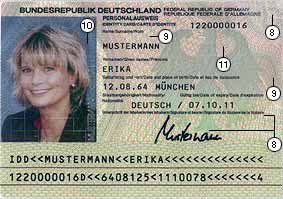
|
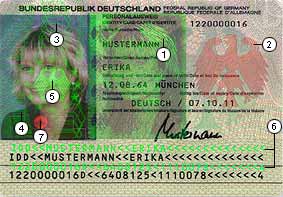
|
| Normal View
|
Viewed from a shallow angle
|
|
secification with the following features may be
incorporated
|
1. Holographic portrait:
(Holographic Shadow
Picture, HSP®):
A second, holographic image of the passport or identity-card
holder's photograph becomes visible to the right of the conventional picture
when the passport page or the ID card is viewed from a shallow angle. The
holographic reproduction process creates a stylised, light-dark image of the ID
photograph's pictorial content into which four motifs of the German eagle are
incorporated on the left-hand side.
2. Identigram®
3D German
eagle:
A three-dimensional image of the
German eagle in red can be detected from a specific viewing angle.
3.
Identigram®
Kinematic structures:
Kinematic structures are arranged above the conventional
photograph; their central element is a German eagle surrounded by twelve stars.
When the passport data page or ID card is tilted from left to right, the eagle
motif, which is visible at the centre, changes – via a hexagonal structure –
into the letter "D". The stars alternately increase and diminish in size. The
hexagons above and below the eagle motif move up and down. A chain of stars on
the right-hand edge of the picture turns into a "D".
4. Identigram®
Macrolettering and
microlettering:
There are kinematic
structures on the left edge of the conventional photograph consisting of a
curved band of macrolettering with the text "BUNDESREPUBLIK DEUTSCHLAND"
(Federal Republic of Germany); several parallel lines of microlettering with the
same text connect with the macrolettering on the left-hand side.
5.
Identigram®
Contrast reversal:
When
the data page or ID card is tilted, the contrast on the surface of the central
eagle motif is reversed, so that the initially light-coloured eagle now appears
dark on a light hexagonal surface.
6.Identigram®
Holographic representation of the
machine-readable lines:
The two
machine-readable lines of the data page or ID card are repeated as holograms.
These are situated above the conventional machine-readable lines.
7.
Identigram®
Machine-verifiable structure:
The Identigram® has a machine-verifiable structure. This also
enables a machine authenticity check to be made to support visual inspection –
in addition to the machine-reading of the ID. This structure does not contain
any personal or document-related data.
8. Surface embossing:
The data page or ID card is embedded into
a special laminate. A security embossing process gives the document a tactile
relief surface along the right-hand edge. The redesigned embossing contains the
letter "D", the German eagle motif, and the words "BUNDESREPUBLIK DEUTSCHLAND"
(Federal Republic of Germany) and "REISEPASS" (passport) or "PERSONALAUSWEIS"
(ID card).
The following security features remain
unchanged:
9. Security
printing with multi-colour guilloches:
Guilloches are protective patterns made up of fine, interlacing
curved lines in which different-coloured structures fit together perfectly to
form a balanced overall picture. In reproductions (e.g. colour copies) the line
structures of the original are resolved into dotted halftone structures.
10. Laser
lettering:
The passport or
identity-card holder's family name and first name are laser-engraved into the
identification document material at the right-hand edge of the photograph.
11.
Watermark:
When light shines through
the paper of the passport data page or ID card, a multitonal watermark can be
detected in the form of stylised eagles distributed over the
surface.
Other Types of Security CardsThis link will provide an
exaple of another card manufacturer's security features
Notes and recommendations on taking photographs for ID Cards
The following quality features must be observed when taking photographs, in
order to ensure a high standard of reproduction in the identity documents:
Colour cast: In particular, the photograph should reproduce
skin tone naturally without any colour cast.
Illumination: Care should be taken to ensure that every part
of the applicant's face on the photograph is adequately and (in particular)
evenly illuminated.
Contrast: The face should be depicted in high contrast in
order to ensure good reproduction of the colour/grey scale.
Format: The size of the head should be adequately
proportioned to the height of the photograph. Care should be taken to ensure
that there is no bleeding of parts of the face.
Background colour: The background of the photograph should
be in a contrasting colour to the face and hair. For colour photographs, the
background colours beige, light brown, light grey and pale blue are particularly
suitable.
Reflections: In order to aid identification of the bearer,
there should not be any reflections, e.g. from spectacles.
Other remarks:
-
It may be either black-and-white or coloured.
-
No parts of a uniform must be visible on the photograph.
-
If the applicants are required to cover their hair e.g. for
religious or spiritual reasons they can do so, however the full face must be
visible in spite of the head covering.
Fingerprint Verification
The use of field or office fingerprint verifiers are
essential in higher security areas. Below is an example :
Features
• Easy installation, no change to system software
• Fingerprint
verification in less than 1 second
• Multiple finger enrollment for some or
all users
• Administrator selectable security levels. Option of individual
settings
• User selectable PIN data input (Wiegand / proximity / keypad /
MAGTEK & OMRON track 2 and Watermark®)
• Input and output data signals
identical on finger match
• Easy-to-follow LED and user-definable LCD
instructions
• User‘s template held either in Verid‘s internal database or
stored on a magnetic or smart card
• RS485 network for automatic updates of
internal database
• Automatic configuration and database synchronisation of
new units added to a network Product Data
| Features
• Easy installation, no change to system software
• Fingerprint verification in less than 1 second
• Multiple finger enrollment for some or all users
• Administrator selectable security levels. Option of individual settings
• User selectable PIN data input (Wiegand / proximity / keypad / MAGTEK & OMRON track 2 and Watermark®)
• Input and output data signals identical on finger match
• Easy-to-follow LED and user-definable LCD instructions
• User‘s template held either in Verid‘s internal database or stored on a magnetic or smart card
• RS485 network for automatic updates of internal database
• Automatic configuration and database synchronisation of new units added to a network
|
| Size
|
| Depth:
|
60mm
|
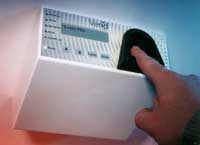
|
| Width:
|
165mm
|
| Height:
|
160mm
|
|
| Power
|
10V - 14V D.C., maximum 500mA
|
| Temperature
|
Operating 0°C to 40°C
|

The first step
towards either a verification or an identification is to go through an enrolment
(registration) process, i.e. extract biometric data, capture it, and create a
template. Extract biometric data (ca 30 000 b) into a template (300 b).
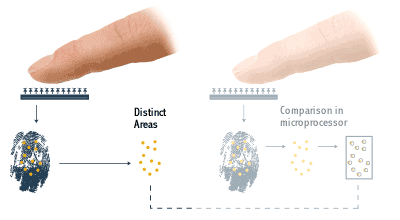
Your fingerprint is read by the sensor,
the distinct area information is extracted, and a template is stored.

Verification (sometimes called authentication) is when a comparison
of newly captured biometric data is made against a stored template to find a
match. This method is a one-to-one method where the verification situation
craves that you are you, not in comparison to anyone else. In the verification
procedure the template is used as an operator acting on the fresh fingerprint
image. If the match is approved, the authentication of the person is completed.
an example of a situation when you need this type of assurance is when a credit
card is used and the cardholder wishes to verify herself.
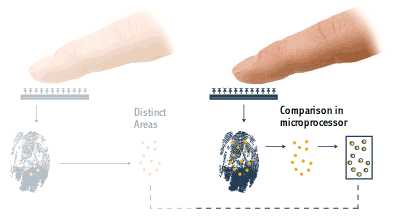

|
A comparison of captured biometric data with
many stored templates in a database is called identification. In the
mornings when you get into work you need to identify yourself to pass
through the entrance. The system is then comparing your fingerprint with
all the already stored tamplates(ID files), and gets a match with your
enroled template.
Or when the need arises to check someone's identity,
perhaps for a financial transaction, then the person usually uses a card,
token, or username to identify the enrolled ID file in a system where
there is many registered users. This file is then matched against the new
template created when the finger is placed again on the sensor.
|
|
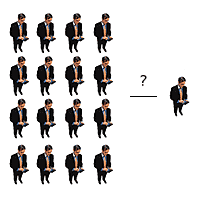
|

Sep 20
2001
World’s First Complete
Biometric Authentication System Under
$10
Fingerprint Cards is introducing
its third generation biometric technology and in doing so
makes it possible, for the first time, for you to purchase a
complete embedded, easy to implement, biometric system for
under $10.
The system consists of our in-house
developed capacitive swipe sensor, FPC1030, and the specially
designed processor, FPC2010, running the most compact
algorithm on the market.
If you are looking for a
user-friendly, secure, small-sized and, above all, a very low
cost biometric system this is the perfect solution for you.
Therefore, in the coming days, we will contact you to tell you
more about this amazing biometric system.
The
Swipe Sensor, FPC1030
· Size: 14x2 mm
· >15 Kv ESD
protection
· Robust surface coating
· LVDS interface, 8
Mpixel/s
· Implemented in a 0.5 um triple metal CMOS
process
The Processor, FPC2010
· Direct
interface to FPC1030
· 44/64 TQFP
· 12kB fingerprint
RAM
· Algorithm support core in H/W
· Finger swipe speed
45 cm/s
The Algorithm
· Distinct Area Detection
(DAD)
· Instant verification
· Software for FPC2010
finger pattern
ASIC
|
Two-dimensional symbology
Two-dimensional symbology development has brought us the considerable
benefits of data carriers that can do the job of a "license plate" linear bar
codes, plus much more.Compared to linear bar codes, two-dimensional symbologies
offer either more data in a small area or the ability to encode complete data
files in an optically readable symbol- both of which extend the potential market
for bar coding into areas which it previously could not venture. The range of
data two-dimensional bar codes can encode is wider and allows for storage of
vast amounts of text data, biometrics, photographs,signatures,etc
Datastrip's 2D SUPERSCRIPT is a high-density two-dimensional bar code
allowing users to store significant amounts of information in the bar code.
Unlike traditional one-dimensional bar codes acting as a "license plate"
pointing to information stored in a computer database, 2D SUPERSCRIPT is the
database. Thus data stored in a 2D SUPERSCRIPT creates a private portable
database.
Security - 2D SUPERSCRIPT can not be altered once
printed.
Durability - Error correction
techniques support complete data restoration with up to 50% database
destruction.
Density - Over
2,100 byte capacity
SMART CARD DIE-ATTACH AND MODULE LAMINATION ALTERNATIVES
http://www.aitechnology.com/sc9.html
Other
The Mozambican government has adopted a decree on a new type
of personal identity card so that production of the card can begin this year.
The new card will be extremely difficult to forge, and in future could also be
used as a voting card.
Interior Minister Almerino Manhenje told reporters that the cost of the
project is about $6.8 million. The government is providing two million dollars
from its own resources, while the rest comes from Spain ($2.5 million) and from
the European Union ($2.3 million).
The new card will be introduced gradually: 1.5 million will be produced this
year, three million in 2000, and 4.5 million in 2001. The maximum cost of a card
will be 30,000 meticais (about $2.5), but around 20 per cent will be issued free
of charge to citizens who cannot afford to pay.
|
 |
|
 |